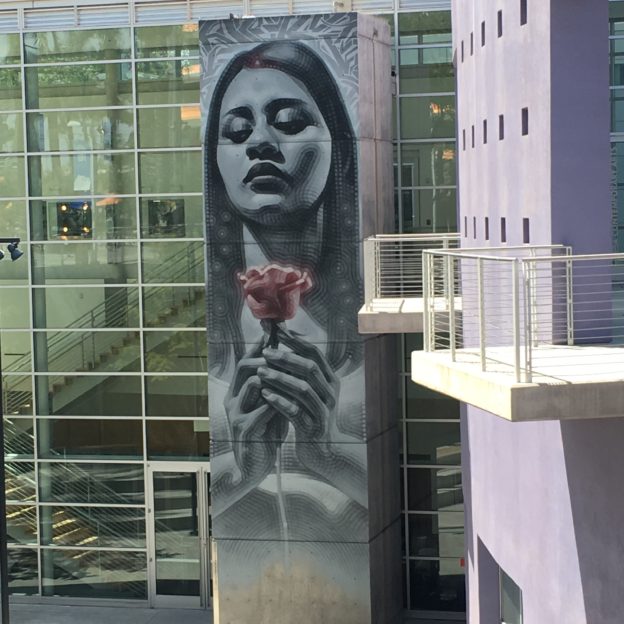(Written for LISC Phoenix. Photo is art adorning the Mesa Arts Center. )
The arts and culture component in comprehensive community development is more than a pop of color in a housing project or a hint of traditional neighborhood vibe. Individual and group stability, civic leadership, creative problem-solving, and hope all spring from intentional efforts to instill arts and culture in community revitalization.
The considered opinion of a panel of experts discussing creative placemaking at an April 6 event in Mesa made clear there is more to arts and culture in community development than meets the eye.
Representatives from the Federal Reserve Board of San Francisco, Artspace, the Kresge Foundation and LISC’s national office discussed artists and the arts economy in community development in the third of a series of discussions in the Valley about creative placemaking. The event was sponsored by the San Francisco Fed, LISC Phoenix and the Mesa Arts Center and it complimented with the ArtPlace Summit in Phoenix.
The stakeholders who attended the creative placemaking event at MAC heard experts discuss how the successful infusion of arts and culture in comprehensive community development requires focused attention on the needs of artists and their families. Some needs are no different from other low-income residents or struggling small businesses. Some are unique to the artist community.
Colin Hamilton, senior vice president of national advancement at Artspace, said a community development focus on “live-work” spaces, such as the planned Mesa Artspace Lofts featuring studios and gallery space, give artists the stability that comes with affordable housing. When completed, the 50-unit project south of Main Street in downtown Mesa will join about 40 Artspace housing projects nationwide that cater to low-income artists and their families.
“Artists who have access to that stability in their lives see their artistic careers grow in lots of ways,” Hamilton said. “They’re more productive, they’re more collaborative, they have more recognition in their community as artists and, most importantly, they earn more money from their artistic work.”
But money isn’t everything. Regina Smith, managing director of The Kresge Foundation’s Arts & Culture Program, said economic measures are not the only selling point for arts and culture in creative placemaking.
“In the arts and culture sector, we tend to think about economic impact as the hook, the thing that actually makes us relevant in our communities, when it’s a fairly blunt instrument,” Smith said. “What we need to do is think about cultural, physical and social impacts in addition because those are the types of things that allows us to think and actually acknowledge changes that are occurring in our communities.”
As senior research associate of community development at the San Francisco Federal Reserve Board, Laura Choi focuses on human development and household financial stability. She touted LISC’s financial opportunity centers, like the one at La Mesita in Mesa, as a model for bundling services that help struggling people find financial coaching, employment advice and access to income supports to achieve stability.
Choi said financial health and well-being is subjective. It’s not just about annual income; it’s about having some control of your life and being on track to achieve financial goals. With that perspective and with a growing understanding of creative placemaking, Choi said she has come to understand “just how deep and lasting meaningful arts culture can mean to a community.”
“The vitality of the community in which you live has a huge impact on your ability to be financially healthy,” Choi said, adding that critically important hope for the future springs from healthy communities.
“This concept of hope is actually really central to getting people to think about their future, wanting to improve their own lives for their future and for their children,” Choi said. ”And so when thinking about creative placemaking, improving the community in which you live, beautifying it, by bringing cultural expression, that is, in many ways, the physical embodiment of hope in the future. ”
Creating that strong sense of place for arts and culture takes time and resources, but the investment has long-term impact that’s expected to span many decades, Hamilton said. Artspace has found after years of creating affordable housing for artists that leaders emerge to help improve the overall health of communities, he said.
“When you also cluster artists together, it created stability among them and for them, and it allowed them to participate in their communities in a different way,” Hamilton said. “They make amazing contributions to the places where they live. The places where arts concentrate tend to become communities that are more vibrant, that are safer, that are more dynamic, that attract business — that simply have a more defined sense of who they are. And in that sense, they create a quality of life spirit that is really an envy to many other communities.”
Lynne McCormack, national director of creative placemaking for LISC, said there is evidence now that community development work focused attention on providing artists with the support necessary to address challenges in disinvested communities can be transformative. Creative placemaking has moved beyond the experimental phase, she said.
“That’s the exciting thing in the work right now,” McCormack said. “Creative placemaking has been at a buzz place for a while, but all of these themes are starting to emerge on the work. It’s a really wonderful time to be doing this.”
